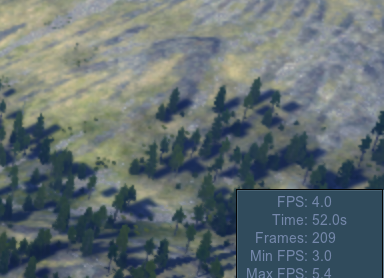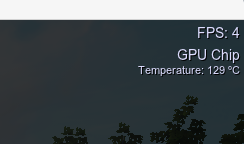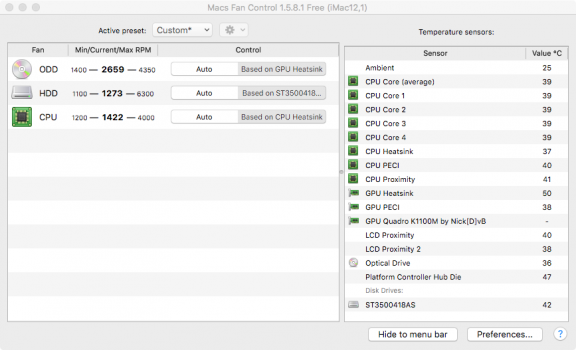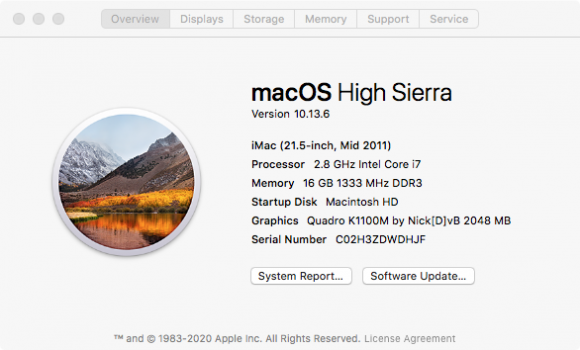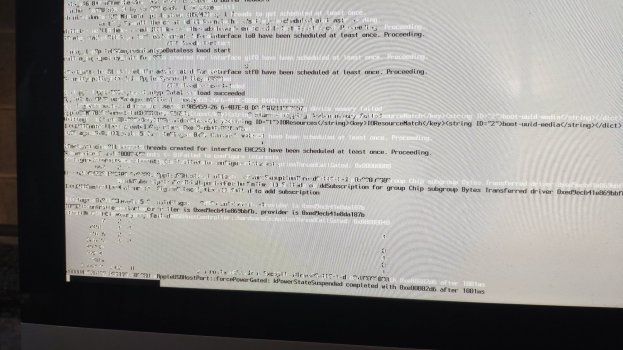i already try the bios from the gt120 but the memory size is different if i get more information then i can build a bios and test it and if it al works i post it hereUse GT130m BIOS.

Got a tip for us?
Let us know
Become a MacRumors Supporter for $50/year with no ads, ability to filter front page stories, and private forums.
iM 4,1-14,4 2011 iMac Graphics Card Upgrade
- Thread starter MichaelDT
- WikiPost WikiPost
- Start date
- Sort by reaction score
You are using an out of date browser. It may not display this or other websites correctly.
You should upgrade or use an alternative browser.
You should upgrade or use an alternative browser.
- Status
- The first post of this thread is a WikiPost and can be edited by anyone with the appropiate permissions. Your edits will be public.
Admittedly I had to look up both your quotes, but in doing so you have made me a slightly more profound user.At least we know now that TDM with M1 will not work...not what I would have expected, but this is "Der Lauf der Dinge" or "panta rhei" for the humanistic more profound users...
While it is slightly off topic, how do I use it in OC 0.6.4?How to patch DSDT to make sound work in Windows10 UEFI
To make sound work in Bootcamp Windows UEFI, you could need to patch DSDT. We have to remove Window's 32-bit PCIe allocation constraint and allow the use of a 64-bit PCIe address space.
You need Maciasl to extract your own DSDT.
View attachment 1686450
Search for DWordMemory. After the last DWordMemory we will inject a QWordMemory.
View attachment 1686451
Code:QWordMemory (ResourceProducer, PosDecode, MinFixed, MaxFixed, Cacheable, ReadWrite, 0x0000000000000000, // Granularity 0x0000000C20000000, // Range Minimum 0x0000000E0FFFFFFF, // Range Maximum 0x0000000000000000, // Translation Offset 0x00000001F0000000, // Length ,, , AddressRangeMemory, TypeStatic)
Compile your modified DSDT and save it as ACPI Language Machine Binary (.aml).
Then you can inject this modified DSDT via OpenCore.
Do I just place the compiled DSDT.aml file in the /EFI/OC/ACPI folder of the OC Catalina Loader or need some further steps to edit the config.plist when used for Mac booting ?
New Catalina Loader based on OpenCore 0.6.4Important: Upload of image is encrypted now just to please Google, password is NICK
Latest version of OpenCore and latest version of the Lilu and Whatevergreen extensions already configured. We have for each card type a special preconfigured config. Just pick yours from the list below and rename it to config.plist
(new, Big Sur on iMac 11,x)
0.6.4 NVIDIA - Nvidia 2009 / 2010 macOS including Catalina
0.6.4 AMD - AMD 2009 / 2010 macOS including Catalina
0.6.4 AMD_BS - Nvidia 2009 / 2010 macOS Big Sur
0.6.4 NVIDIA_BS - Nvidia 2009 / 2010 macOS Big Sur
0.6.4 NVIDIA 2011 21.5 and 27 (enabled UEFI Windows sound patch)
0.6.4 AMD 2011 21.5 and 27 (enabled UEFI Windows sound patch)
0.6.4 BSINSTALL - to be used with Big Sur INSTALLATION on on iMac Late 2009 and Mid 2010 and all
cards
1. Big Sur installation using this micro patcher:
You need to disable the iMacPro1,1 spoofing during the patch process (step 15)! Otherwise the system identification and patching will fail to select the correct patch set!
Q0: What is the single - important - need to be done in advance prerequisite?
Backup your iMacs firmware using @dosdude1 program named romtool (link on first post)!
Q1: How to install the image on an SD/USB?
Installation on an SD card or USB flash drive is simple: Use the disk utility to restore the card/drive from the image you downloaded and unpacked before. The Catalina Loader is now an empty stack. It will need to have an EFI folder you get from the additional packages (currently 0.6.0 and 0.6.3).
Q2: Where to find these config files you are talking about?
You will find the config files on the image in the EFI/OC folder. Please check my previous post for more a documentation and more detailed info.
Q3: How to use a specific config file provided here?
Delete the existing config.plist file, make a copy of your target file and rename this to config.plist. Reboot the system and choose the Catalina Loader either on boot with alt/option or using the system preferences and the start object selection (AMD GOP BIOS users):
Q4: How to use the different versions of OC EFI folders?
First download the additional archive, unzip it and move the folder named EFI directly onto the Catalina Loader image (picture attached).
Q5: Why separate only an EFI folder and no complete Catalina Loader image?
6 times the space needed and 10 times the time needed for me to maintain and upload such a new image.
Q6: So I really need the SD/USB card all the time?
Yes, there is no way around booting OpenCore to get the enhancements wanted. Users of NVIDIA cards or EG modded AMD BIOS may install the EFI folder into the EFI partition if their boot drive. Users of AMD GOP BIOS versions not having a native boot picker should stick with the external SD/USB version. If things to wild changing the config you can always just plug the USB/SD. Otherwise you will need to reopen your iMac to force a boot selection by plugging HD cables. Not a real option, right?
Q7: Will my iMac Late 2009 or iMac Mid 2010 boot Big Sur using this?
Yes, using the OC 0.6.3 and the config files for BS will install and run Big Sur. For an unknown reason you will have to use a special config.BSINSTALL.plist only while installing. After installing you should change the config file according to your GPU (NVIDIA or AMD). Choose the file and rename it to config.plist to make it active on the next reboot.
Q8: Where is PolarisBoostMAX?
@Pascal Baillargeau released a new version of the stock PolarisBoost. It has the same features and is save to use with the WX7100, too.
Q9: How can I get Windows 10 UEFI sound back on my iMac Mid 2011 (model 12,x)?
Open the config.plist you currently use and go to the ACPI section and enable the fitting DSDT patch.
Q10: I cannot make the CL the start object! How to solve this?
Just have a single Catalina Loader installed on your iMac and eject and remount the image once. The mount point needs to be/Volumes/Catalina Loader- usemountordiskutil listto check this.
Q11: I cannot select the CL image in Big Sur (not included in selection)?
Boot another older macOS version and select it there. Known issue.
Q12: Cannot use this with High Sierra, what to do?
Use the 0.5.9 folder - the functionality is the same. Somewhere on the road a fork has been used to make newer version not booting into High Sierra.
Q13: Where are the Big Sur files in the 0.6.3 version gone?
I pulled them back to make sure you are using the 0.6.4 and newer - this is the Big Sur version of OpenCore.
Q14: Can I just using the Apple OTA upgrades visible within the system preferences.
Dangerous game: Although there are heavy efforts made to block unwanted firmware upgrades to your (old) iMac it may come through creating a nice big brick on your real desktop. Only possible in theory with 0.6.4 (as of now) and even there complicated. The the internal disks EFI folder for firmware upgrades and delete them. If you do not know what I am writing about forget the idea to use Apple upgrades.
EDIT:
12/08/2020: Added 0.5.9 EFI folder back for High Sierra users.08/13/2020: Added config.AMD.MAX.plist and changed image.
08/20/2020: The Lilu and Whatevergreen versions available on GitHub may change over time. Please check yourself if more recent versions are available.
08/23/2020: Upgraded all config.plist version with "run-efi-updater" "No" in the NVRAM section to avoid firmware updates. added back the older version of the GPU_Monitor_ORIG script to watch the temp data for AMD cards.
08/24/2020: attached former version AppleBacklightFixup.kext more suitable for K1100M, K2100M, K610M ?
10/08/2020: uploaded OC 0.6.2 image, possibly Nvidia users should replace AppleBacklightFixup on the image with the separate attached one, changed csr-active-config in the light of upcoming Big Sur, latest Whatevergreen and Lilu, SystemAudioVolume=25, different files for different AMD cards, added display ID F10T9cde to AppleBacklightFixup on image
10/09/2020: uploaded compressed image to fit on 1GB USB drives or SD cards, added display ID F10T9cde to attached separate file AppleBacklightFixup
11/01/2020. Uploaded new image 0.6.2 containing just new plist files. Check it out an report back. You can edit the plist files yourself using the Open Core Configurator.
11/13/2020: Uploaded disk image only containing the EFI folder of 0.6.3. This includes the config.plist versions to be used to install and run Big Sur on iMac Late 2009 and Mid 2010.
11/13/2020: Uploaded EFI folder of OC version 0.6.0 and 0.6.3.
11/20/2020: Replaced the old complete 0.6.0 CL image with an encrypted empty one and two archives with EFI folders.
12/09/2020: Added to 0.6.3 EFI folder a config.NVIDIA.HS.plist for High Sierra users.
12/10/2020: Added 0.6.4 EFI folder
Many thanks to @Nick [D]vB, @highvoltage12v, @jborko, and @Pascal Baillargeau for creating the contents.
Disclaimer: You just made a Hackintosh out of your iMac. There are some risks related to this method. You take all this risks on your own!
Important: Upload of image is encrypted now just to please Google, password is NICK
Hey, it's nice to have update to 0.6.4, but it still gives me error not bootable image (missing partition table) if i try to load the image with balena etcher, and it still seems impossible to understand exactly how this thing work to fix it. It does not seem like the procedure you write is fully tested and understood. My guess is that the image being password protected is the issue? I'v reported this 2 weeks ago already, tryn again with a different computer, on a different machine and all, same issue.
There are at least 3 other guides linked in various parts and they are all mixed up and broken at some point.
Check post #8044 for brightness you need to replace kextHello everyone! Thank you all for the great work done. You guys do wonders. I installed 780m in my imac 2011 and installed Big Sur. Everything works great.
But there is one problem: I cannot set the screen brightness kekst. Used micro patcher. When disabling SIP via recovery, an error appears at startup. Without disconnecting, nothing is installed, respectively. What do I need to do to get my imac to work? Please help!
Place DSDT.aml file in the /EFI/OC/ACPI folder of the OC Catalina Loader and edit config.plist.While it is slightly off topic, how do I use it in OC 0.6.4?
Do I just place the compiled DSDT.aml file in the /EFI/OC/ACPI folder of the OC Catalina Loader or need some further steps to edit the config.plist when used for Mac booting ?
Any idea? I have all the sensors plugged in and working correctly, except the one for the gpu, so I can't find the problem.Also, does anyone know why do I get such a low score in Geekbench Metal benchmark? ( using k1100m ) ( And in Unigine Valley on medium 1080p I get around 5-6 fps )
Hi. I have the same problem. And I don't know how to fix it. (iMac 21.5, i7-2600s, K1100M)Any idea? I have all the sensors plugged in and working correctly, except the one for the gpu, so I can't find the problem.
Hey guys, help, please!
Attachments
iMac 2011 should natively support High Sierra.Hi. I have the same problem. And I don't know how to fix it. (iMac 21.5, i7-2600s, K1100M)
Hey guys, help, please!
So, that should not be related to the Legacy Video patch in Catalina Patcher ...
Generally, the Unigine Valley FPS were reported to be ~20+ for K1100M.
So, I have no clue why yours are so slow ...
Regarding the GPU temp sensor both of your go back to the first post and start reading there again.Hi. I have the same problem. And I don't know how to fix it. (iMac 21.5, i7-2600s, K1100M)
Hey guys, help, please!
I cannot comment on your cards performance since both of you ignored to provide any substantiell information about the software configuration.
Please add a signature to your account - as we all did - showing your hardware config.
This will not work!While it is slightly off topic, how do I use it in OC 0.6.4?
Do I just place the compiled DSDT.aml file in the /EFI/OC/ACPI folder of the OC Catalina Loader or need some further steps to edit the config.plist when used for Mac booting ?
While @Pascal Baillargeau and me are doing right now extensively testing with the OC 0.6.4 we cannot help in parallel others to experiment on this, too.
You may just use what we already explored and test it (and help us and others) or your are doing your own tests. This will become just a waste of resources otherwise.
It's easy to decrypt the image and create a decrypted image from the terminal, which you can then burn with Disk Utility or other tools:Hey, it's nice to have update to 0.6.4, but it still gives me error not bootable image (missing partition table) if i try to load the image with balena etcher, and it still seems impossible to understand exactly how this thing work to fix it. It does not seem like the procedure you write is fully tested and understood. My guess is that the image being password protected is the issue? I'v reported this 2 weeks ago already, tryn again with a different computer, on a different machine and all, same issue.
There are at least 3 other guides linked in various parts and they are all mixed up and broken at some point.
Code:
hdiutil convert -format ULMO -o CL.dmg Catalina\ Loader.dmgWill ask password and create a decrypted and lzma compressed image "CL.dmg" out of the encrypted "Catalina Loader.dmg".
Maybe @Ausdauersportler can include this tip on the Catalina Loader FAQ
A small note about Dummy VGA Plug.
When I use the Dummy VGA Plug instead of a real external monitor, it takes longer to switch from the Boot Selection screen to the log-in screen.
Boot Chain is as follow:
- OC Catalina loader SD card (0.6.0)
- Select High Sierra
- Apple Logo + loading bar running.
- Screen turn black, then log-in screen shows up
When using the external monitor (mDP to VGA adapter + VGA cable), the black-out time is less than 1 second.
When using the Dummy VGA plug, it's 5~6 second, sometimes up to 10 seconds.
My configuration is in my signature (iMac 2010 + WX4150 4GB)
Without the external VGA plug or the external monitor, the internal 27" screen is black forever. I don't use the patch.
When I use the Dummy VGA Plug instead of a real external monitor, it takes longer to switch from the Boot Selection screen to the log-in screen.
Boot Chain is as follow:
- OC Catalina loader SD card (0.6.0)
- Select High Sierra
- Apple Logo + loading bar running.
- Screen turn black, then log-in screen shows up
When using the external monitor (mDP to VGA adapter + VGA cable), the black-out time is less than 1 second.
When using the Dummy VGA plug, it's 5~6 second, sometimes up to 10 seconds.
My configuration is in my signature (iMac 2010 + WX4150 4GB)
Without the external VGA plug or the external monitor, the internal 27" screen is black forever. I don't use the patch.
Last edited:
Please go back to the very first announcement of the Catalina Loader made by @Nick [D]vB and read it. The error message shown by the balena etcher is not important.It's easy to decrypt the image and create a decrypted image from the terminal, which you can then burn with Disk Utility or other tools:
Code:hdiutil convert -format ULMO -o CL.dmg Catalina\ Loader.dmg
Will ask password and create a decrypted and lzma compressed image "CL.dmg" out of the encrypted "Catalina Loader.dmg".
Maybe @Ausdauersportler can include this tip on the Catalina Loader FAQ
Additionally I deleted the balena etcher from my post forcing the people to use the (Apple) disk utility. This tool will automatically ask for the password and will happily decrypt and restore an image to an SD card, USB memory thumb drive or even to a small MacOS extended partition and the end of your internal drive (please do not use the first partition for this).
Long story short: DO NOT USE THE BALENA ETCHER.
EDIT: Put your command to Q15 of the FAQ of the Catalina Loader download post....
Last edited:
There is no HEVC support on this GPU, there is no HEVC support with your CPU. You could have known this by reading the first post in advance and your can fix this by buying an AMD Polaris card.After upgrading iMac 2011 27" to K2100M and installing Catalina 10.15.7 I cant play HEVC videos (from photo app). How to fix that?
Please add a signature to your account - as we all did - showing your hardware config.
This 6679 MOSFET also appeared on eeprom-less WX4170 cards, as described in this post. Oddly the cards that came with bios chip are missing the MOSFET, I wonder what it is used for...I have the same card here waiting for.. anything. The Dell(?) ones posted here in this thread (109-C98581-00D_02) differ, the HP ones (mine and yours) have a p-channel MOSFET (a Fairchild FDMC6679AZ) around pin 1, which also is not combined into one big plate (pin 1-9 and pin 11-17). Pins 1 to 9 might be gound, but not sure about 11+13 and 15+17, both link to a via-connection to the other side.
I have one of this WX4170 without bios chip and I'm planning on doing some tests with it during christmas holidays. Apparently soldering a bios chip is not enough, most probably shorting R1342 is also needed, and maybe something else...
Last edited:
I'm running High Sierra 10.13.6 alongside Catalina Loader ( NVIDIA_2011_27 config ) and rEFInd on my iMac 27" 2011 with a K1100M. Also I tried target display mode with a mbp 15" 2017 and it's not working. ( 2m thunderbolt 2 cable and a tb3 - tb2 bidirectional adapter )Regarding the GPU temp sensor both of your go back to the first post and start reading there again.
I cannot comment on your cards performance since both of you ignored to provide any substantiell information about the software configuration.
Please add a signature to your account - as we all did - showing your hardware config.
Yeah, that's the madness of this thread, having to compile parts from different guides into one until by magic it works - cross referencing the same guide written 4 times with broken links, missing parts eccPlease go back to the very first announcement of the Catalina Loader made by @Nick [D]vB and read it. The error message shown by the balena etcher is not important.
Additionally I deleted the balena etcher from my post forcing the people to use the (Apple) disk utility. This tool will automatically ask for the password and will happily decrypt and restore an image to an SD card, USB memory thumb drive or even to a small MacOS extended partition and the end of your internal drive (please do not use the first partition for this).
Long story short: DO NOT USE THE BALENA ETCHER.
EDIT: Put your command to Q15 of the FAQ of the Catalina Loader download post....
Anyway, moving on; apparently the Catalina Loader is a chainloader for opencore, to allow the startup disk utility to "see" it as bootable. That is the missing information i was looking for and i figured out when i was finally able to find a working image to burn.
Now, moved to booting opencore, the system hangs at prohibited sign. What i did was
1 install k2100m with modded vbios, working fine in High Sierra
2 install Catalina with newest patcher from dosdude, i was used to a previous version that had manual setting for patches, so it did not work until i modified the plist to remove the graphics patch
3 isntall the agc patch with your automated tool tool , otherwise i needed to pram reset every time to boot (exactly opposite as reported on page 1) , working fine
4 now i was able to boot to opencore, but it loads to stop sign, using verbose the last message i get is the one attached, i found no reference on this thread - i asked before doing the agc patcher tool if that was compatible with the opencore boot but got no answer, is that the issue ?
Attachments
Why don't you try Big Sur? It's running very well on my iMac with a k1100m (but I accidentally formated the drive trying to install windows :/ )Yeah, that's the madness of this thread, having to compile parts from different guides into one until by magic it works - cross referencing the same guide written 4 times with broken links, missing parts ecc
Anyway, moving on; apparently the Catalina Loader is a chainloader for opencore, to allow the startup disk utility to "see" it as bootable. That is the missing information i was looking for and i figured out when i was finally able to find a working image to burn.
Now, moved to booting opencore, the system hangs at prohibited sign. What i did was
1 install k2100m with modded vbios, working fine in High Sierra
2 install Catalina with newest patcher from dosdude, i was used to a previous version that had manual setting for patches, so it did not work until i modified the plist to remove the graphics patch
3 isntall the agc patch with your automated tool tool , otherwise i needed to pram reset every time to boot (exactly opposite as reported on page 1) , working fine
4 now i was able to boot to opencore, but it loads to stop sign, using verbose the last message i get is the one attached, i found no reference on this thread - i asked before doing the agc patcher tool if that was compatible with the opencore boot but got no answer, is that the issue ?
It is actually what i was thinking about ATM, might aswell go there, but at the same time i wanted the "original" part to be stable and not venture in a new release...also i'd like to know why the heck i can't get this thing to work after all the daysWhy don't you try Big Sur? It's running very well on my iMac with a k1100m (but I accidentally formated the drive trying to install windows :/ )
Me too, I've been trying to install Windows 7/10 on my iMac for the past few days but none of the methods on the internet worked... And also Target Display Mode doesn't work, the thing that made me buy this iMac, even with a thunderbolt macbook... Looks like I'm going to sell it if I don't fix at least the Target Display Mode in 2-3 weeks from now...It is actually what i was thinking about ATM, might aswell go there, but at the same time i wanted the "original" part to be stable and not venture in a new release...also i'd like to know why the heck i can't get this thing to work after all the days
Edit: Also, if you want a stable OS, I recommend High Sierra with the 2020=006 update, runs quite well for the "original" part of the system, it runs natively, and maybe you can get Target Display Mode working...
This is really off topic and there an dozens off other threads on this forum describing how to install Windows 10 on the iMac 2011, even Dr. Google helps. This is not the general iMac 2011 thread, the topic is the GPU change and the software development needed for this.Me too, I've been trying to install Windows 7/10 on my iMac for the past few days but none of the methods on the internet worked... And also Target Display Mode doesn't work, the thing that made me buy this iMac, even with a thunderbolt macbook... Looks like I'm going to sell it if I don't fix at least the Target Display Mode in 2-3 weeks from now...
Edit: Also, if you want a stable OS, I recommend High Sierra with the 2020=006 update, runs quite well for the "original" part of the system, it runs natively, and maybe you can get Target Display Mode working...
--
W10:
This methods works on Mid 2010 and even on Mid 2011 unless you install a second disk into your 2011 iMac!! So the solution will be to disconnect the second HDD/SDD during installation. Another solution might be to change the boot order within the iMac BIOS - which I have seen only one time after experimenting with a clean firmware onto one of my systems.
https://gist.github.com/oznu/8796d08d73315483c3b26e79a8e3d350
The only different thing to do is is this:
Within the initial Win10 installation dialog the prepared FAT partition is shown. Just delete this partition creating some free space on the disk, select this free space and press proceed. The installer creates new a single NTFS and some helper partitions and starts with copying the data from the USB to the NTFS partition.
Having a second SSD/HDD connected to the system creates this error:
We couldn't create a new partition or locate an existing one.
So I was doing a clean install of windows 10 using a USB and I deleted all the partitions including the system reserve one. The only drive left now is "Drive 0 Partition 1". It is set as primary. The
answers.microsoft.com
--
It is a long way to create this W10 USB installer and patch boot camp to allow downloading the boot camp software. But after creating such an installer you can reuse it on any iMac whiteout going through this, again.
It will not work on the Late 2009, the BIOS of this machine does not allow to boot W10 off an USB device (USB thumb drive). But you can install Windows 10 using this method and move the disk later over into the 2009 system.
Last edited:
This is the answer I was looking for, thanks a lot! But also, do you know what could be causing TDM to not work? I'm even using a Magic KeyboardThis is really off topic and there an dozens off other threads on this forum describing how to install Windows 10 on the iMac 2011, even Dr. Google helps. This is not the general iMac 2011 thread, the topic is the GPU change and the software development needed for this.
--
W10:
This methods works on Mid 2010 and even on Mid 2011 unless you install a second disk into your 2011 iMac!! So the solution will be to disconnect the second HDD/SDD during installation. Another solution might be to change the boot order within the iMac BIOS - which I have seen only one time after experimenting with a clean firmware onto one of my systems.
https://gist.github.com/oznu/8796d08d73315483c3b26e79a8e3d350
The only different thing to do is is this:
Within the initial Win10 installation dialog the prepared FAT partition is shown. Just delete this partition creating some free space on the disk, select this free space and press proceed. The installer creates new a single NTFS and some helper partitions and starts with copying the data from the USB to the NTFS partition.
Having a second SSD/HDD connected to the system creates this error:

We couldn't create a new partition or locate an existing one.
So I was doing a clean install of windows 10 using a USB and I deleted all the partitions including the system reserve one. The only drive left now is "Drive 0 Partition 1". It is set as primary. Theanswers.microsoft.com
--
It is a long way to create this W10 USB installer and patch boot camp to allow downloading the boot camp software. But after creating such an installer you can reuse it on any iMac whiteout going through this, again.
It will not work on the Late 2009, the BIOS of this machine does not allow to boot W10 off an USB device (USB thumb drive). But you can install Windows 10 using this method and move the disk later over to the 2009 system.
Obviously your understanding of collaboration on this thread is asking questions and waiting for answers.This is the answer I was looking for, thanks a lot! But also, do you know what could be causing TDM to not work? I'm even using a Magic Keyboard
This was the last answer you got...
Register on MacRumors! This sidebar will go away, and you'll see fewer ads.


